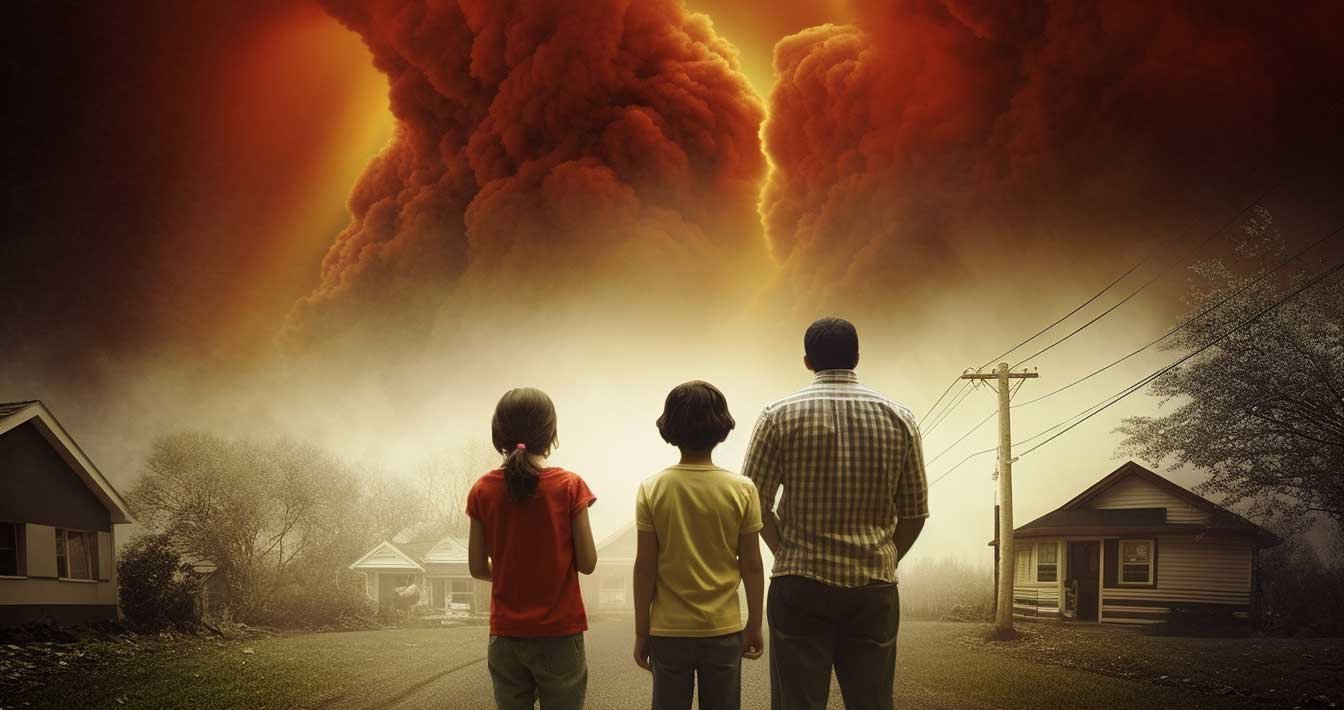Today, we’re going to walk through creating your own Family Emergency Plan, step by step. Life is unpredictable, and sometimes that means we have to face emergencies. But just because we can’t predict them doesn’t mean we can’t prepare for them. And when it comes to your family, having an emergency plan can make all the difference.
Understanding Different Types of Emergencies
First things first: let’s talk about what kind of emergencies you might face. From natural disasters like hurricanes and earthquakes, to home emergencies like fires or gas leaks, different situations call for different responses. It’s also important to consider the specific types of emergencies common in your area. You might not have to worry about hurricanes if you live in a landlocked state, but winter storms or tornadoes might be a common occurrence.
Common types of emergencies and their impacts
Emergencies come in many shapes and sizes, and understanding the common types and their potential impacts can help us better prepare for them. Here are a few examples:
 Natural Disasters: These include events like hurricanes, earthquakes, tornadoes, floods, and wildfires. The impact of these disasters varies, but they often lead to large-scale destruction. For instance, hurricanes and floods can cause extensive water damage and power outages, while wildfires might lead to evacuations and poor air quality due to smoke. Earthquakes can cause infrastructure damage, making roads impassable, and potentially leading to gas leaks or fires.
Natural Disasters: These include events like hurricanes, earthquakes, tornadoes, floods, and wildfires. The impact of these disasters varies, but they often lead to large-scale destruction. For instance, hurricanes and floods can cause extensive water damage and power outages, while wildfires might lead to evacuations and poor air quality due to smoke. Earthquakes can cause infrastructure damage, making roads impassable, and potentially leading to gas leaks or fires.
Home Emergencies: This category covers incidents like house fires, gas leaks, or even a home intrusion. A fire in your home can be devastating, potentially leading to a total loss of property and posing serious risks to life. It requires immediate evacuation. Gas leaks, on the other hand, can cause health issues and present a risk of explosion if not promptly addressed. A home intrusion might require a different response, such as finding a safe place within the home to hide and contacting law enforcement.
Health Emergencies: These can be personal, like a family member suffering from a severe or sudden illness or injury, or widespread, like a pandemic. The impact here can be both immediate and long-lasting. In the case of a personal health emergency, fast access to medical supplies and professional help is crucial. For widespread health emergencies like a pandemic, the effects can change daily routines over extended periods, requiring us to adapt our work, school, and social habits to stay safe.
Technological and Industrial Accidents: This could include everything from a power outage to chemical spills or nuclear accidents. These incidents can lead to both immediate and long-term health risks, displacement from homes, or disruption of essential services.
Understanding these different types of emergencies and their impacts can better inform our Family Emergency Plan, ensuring we’re as prepared as possible for whatever comes our way.
Importance of identifying potential emergencies in your area
The emergencies you prepare for should reflect what you’re most likely to face. That means considering the climate, geography, and even the building materials of your home. Check local resources to get an idea of what to plan for.
Identifying Family Needs and Responsibilities
Now, let’s talk about your family. Everyone is unique, which means your Family Emergency Plan should be too.
Consideration of each family member’s needs and abilities
When creating your plan, take into account the specific needs and abilities of each family member. This includes considering mobility issues, dietary requirements, medical needs, and even your pets!
Determining individual responsibilities during an emergency
 Having a clear understanding of who does what in an emergency can make a significant difference in how efficiently and effectively your family responds. Here are a few things to consider when determining individual responsibilities:
Having a clear understanding of who does what in an emergency can make a significant difference in how efficiently and effectively your family responds. Here are a few things to consider when determining individual responsibilities:
Age and Ability: Clearly, an adult or older child will be able to take on different tasks compared to a younger child. Assign responsibilities based on what each person can safely and effectively do. For instance, teenagers might be able to assist with first aid or gathering emergency supplies, while younger children can focus on sticking close to an adult or taking care of a pet.
Skill Sets: If a family member has specific skills or training, such as medical knowledge, they should be assigned tasks that make the best use of those skills. For example, if you’ve got a scout in the family, they’d be great at handling outdoor survival tasks.
Location: If certain family members are usually in particular areas of the house, it might make sense to assign them responsibilities connected to that area. For instance, if your teenager’s room is closest to the family’s emergency supply kit, they could be responsible for grabbing it during a home evacuation.
Backup Plans: For every task, make sure there’s a backup person assigned in case the primary person isn’t home or can’t perform their duty for some reason.
Here are a few individual responsibilities you might consider:
Communications Coordinator: This person could be in charge of sending out a message to a list of contacts to let them know you’re safe, or to ask for help.
Emergency Kit Handler: Assign someone the responsibility of retrieving your emergency kit if you have to evacuate quickly.
Pet Caretaker: Pets are part of the family too, so someone should be tasked with grabbing the pet carrier, pet food, and making sure pets are safely evacuated.
Family Lead: This person would ensure everyone is accounted for, help guide the family to safety, and make crucial decisions.
The key to determining individual responsibilities is to consider each family member’s abilities and the needs of your family as a whole. With clear responsibilities, every family member can play their part in ensuring everyone’s safety during an emergency.
Establishing a Communication Plan
Communication can become tricky in an emergency, but it’s key to ensuring everyone’s safety.
Options for communication during an emergency
Communication is critical during an emergency. However, regular modes of communication might be disrupted, so having alternative options is a crucial part of your Family Emergency Plan. Here are a few you might consider:
Cell Phones: In many cases, a cell phone can be a lifeline during an emergency. It allows for calls, texts, and internet access to reach emergency services, inform family members of your status, or gather information about the emergency. Be aware that during widespread disasters, local cellular networks may become overwhelmed or go down, so it’s good to have other options too.
Landline Phones: While they may seem outdated in our digital age, landlines can be valuable during emergencies. They often remain operational during power outages or when cell networks are down.
Emergency Radios: These are designed to receive broadcasts from the Emergency Alert System and NOAA Weather Radio. They can provide crucial information during natural disasters and come in hand-cranked or battery-operated models in case of power failure.
Social Media and Apps: Platforms like Facebook, Twitter, and WhatsApp can be helpful for communicating during emergencies. For example, Facebook’s Safety Check feature allows users to notify their network that they are safe. Similarly, apps like Red Cross Emergency offer real-time alerts and a feature to connect with family members.
Satellite Phones: These can be a valuable, though more expensive, option. They rely on satellites instead of local networks, so they can provide communication even when other systems are down.
Two-Way Radios: Also known as walkie-talkies, these devices can be very useful, especially if cell service is down. They don’t rely on a central network, so they’re often more reliable in emergencies.
Whistles: Simple but effective. A whistle can be used to signal others if you’re in immediate danger or trapped.
Remember, effective communication can make a significant difference during emergencies. It’s always a good idea to have several options available, just in case.
Creating a list of important contacts
Include a list of important contacts in your Family Emergency Plan. This should go beyond emergency services and include a trusted friend or family member who lives outside your area, as they can help coordinate if local services are overwhelmed.
Planning Evacuation Routes and Safe Places
Next, let’s focus on getting to safety.
Importance of having pre-determined evacuation routes and safe spaces
When an emergency strikes, every second counts. Having pre-determined evacuation routes and safe spaces is crucial to ensure the safety of your family. Here’s why:
Swift Action: When an emergency occurs, confusion and panic can set in, making decision-making challenging. Having pre-planned routes means less thinking and faster action, which could potentially save lives.
Avoiding Danger: In certain emergencies, like a fire or gas leak, staying in your home can be dangerous. Having a pre-determined route can guide you away from danger as quickly and efficiently as possible.
Familiarity: Knowing your escape routes and safe spaces in advance allows you and your family to become familiar with them. This familiarity can make the actual evacuation process less stressful.
Accessibility: In the event of certain disasters like floods or wildfires, main roads could be blocked. Multiple pre-determined routes provide alternatives to escape safely.
Meeting Place: In the chaos of an emergency, family members might get separated. A pre-determined safe space outside of your home acts as a rendezvous point, ensuring everyone knows exactly where to go to find each other.
Safety Assurance: For those living in regions prone to natural disasters like tornadoes or hurricanes, having a designated safe room, storm shelter, or an understanding of the safest place in your home can provide a critical refuge.
Remember, the goal of having pre-determined evacuation routes and safe spaces is to guide your family to safety as swiftly and safely as possible when an emergency occurs. Practice these routes regularly and ensure every family member, including the children, are well versed in them.
Factors to consider when choosing an evacuation route and safe place
When establishing your family’s emergency evacuation routes and safe places, several factors should be considered to ensure the plan is practical, effective, and safe. Here are some of the key considerations:
Type of Emergency: The nature of the emergency will influence your chosen route and safe place. For instance, in a fire, your route needs to avoid areas that are likely to be blocked, while during a tornado, your safe place might be a storm cellar or a small, windowless, interior room on the lowest level of your home.
Multiple Routes: Don’t just have one evacuation route. Having multiple options is important in case your primary route is blocked or unsafe.
Distance and Time: Your evacuation routes should be as short and quick as possible, leading you to safety in the least amount of time. However, they should also avoid areas that could potentially be hazardous in an emergency, such as bridges during an earthquake.
Accessible Roads: The routes you choose should ideally be on main roads that are well maintained and less likely to be closed or impassable. However, be prepared with secondary routes that utilize smaller roads just in case.
Destination: Consider where your evacuation route is leading you. It could be a local evacuation center, the home of a friend or relative, or a predetermined meeting place that is safe and where all family members can gather.
Special Needs: Consider the needs of all family members. For example, if a family member uses a wheelchair, the route and safe place must be accessible. If you have pets, your destination should be pet-friendly.
Practicality: The routes and safe spaces must be practical and feasible for your family. A good route on paper is not useful if it’s too complex for family members to remember or follow.
Once you’ve determined your evacuation routes and safe places, make sure everyone in your family understands them. Regularly review these plans and practice evacuation drills. This ensures that if an emergency does occur, every family member knows exactly where to go and what to do.
Assembling Emergency Supplies and Kits
You never know what you’ll need in an emergency, so it’s best to be prepared.
Essential items for an emergency supply kit
Your emergency kit should include first aid supplies, water, non-perishable food, flashlights, batteries, and necessary medications. Don’t forget to include items for your pets and any specific necessities for family members, like baby supplies or special dietary foods.
Importance of maintaining and updating your emergency kit
Just having an emergency kit isn’t enough – it’s crucial to maintain it too. This means checking expiry dates, replacing used or outdated items, and updating it as your family’s needs change.
Drafting the Family Emergency Plan
With all this information, you’re ready to start drafting your Family Emergency Plan.
Key elements to include in the plan
The plan should include all the factors we’ve discussed: potential emergencies, family needs and responsibilities, a communication plan, evacuation routes, safe places, and your emergency kit. It should be detailed but concise.
Tips for making the plan comprehensive yet easy to understand
Try to keep your plan straightforward and simple. It should be easy for all family members to understand. Use clear, actionable language, and consider using visuals like maps or checklists.
Training and Practicing the Emergency Plan
Your Family Emergency Plan is only as good as your family’s understanding of it.
The role of drills in ensuring everyone knows what to do
You’ve created your Family Emergency Plan, but how can you ensure that everyone knows what to do when an emergency strikes? The answer is drills. Drills play a crucial role in preparedness, and here’s why:
Familiarity: Drills help to familiarize everyone with the procedures, routes, and safe places that have been established in your plan. This way, in an actual emergency, everyone knows what to do and where to go because they’ve done it before.
Reducing Panic: Emergencies can be scary, especially for children. Regular drills can make the process less frightening because it’s something they’ve practiced and understand.
Testing the Plan: Drills provide an opportunity to test your emergency plan in a safe and controlled setting. You can identify areas of the plan that may not work as intended and make necessary adjustments.
Building Confidence: The more you practice, the more confident each family member becomes in their role during an emergency. This confidence can be critical in helping to keep everyone calm and focused during a real emergency.
Speed and Efficiency: Regular drills can help improve the speed and efficiency of your family’s response to an emergency. You can time your drills to strive for faster evacuation times.
Reinforcing Lessons: Especially for younger children, repetition helps reinforce lessons. The more they practice their role in an emergency, the more likely they are to remember what to do when the time comes.
Identifying Individual Challenges: Drills can help identify if anyone in your family is struggling with their role or responsibilities in the plan, allowing for adjustments or additional training.
By incorporating regular drills into your Family Emergency Plan, you help ensure everyone knows their roles, understands the plan, and can act swiftly and confidently during an emergency. It’s not just about having a plan—it’s about knowing your plan inside and out.
Guidelines for how often to review and practice the plan
Aim to review and practice your plan at least twice a year. It’s also a good idea to revisit it whenever there are significant changes in your family, like a new member or a move to a new home.
Building a Family Emergency Plan might seem daunting, but by breaking it down into steps, it becomes manageable. Remember, the goal is to keep your loved ones safe and prepared for whatever may come.
I hope this guide has inspired you to start creating your Family Emergency Plan, or at least given you some food for thought. Remember, preparation is the best protection against the dangers we can’t predict.
References
There are many resources available to help you create your Family Emergency Plan. Here are a few to get you started:
FAQ
Q: How detailed should my Family Emergency Plan be?
A: Your plan should be detailed enough that it provides clear instructions, but not so complicated that it’s hard to understand or remember.
Q: How often should I update my emergency kit?
A: You should check your emergency kit at least once a year to replace expired items and adjust for any changes in your family’s needs.
Q: What if my family gets separated during an emergency?
A: Your Family Emergency Plan should include a predetermined meeting place and communication plan to help you reconnect. Remember, during widespread emergencies, local communication networks may be overloaded or down, so consider including out-of-area contacts in your plan.
Q: How can I make my kids understand the importance of the emergency plan?
A: Make the learning process interactive and age-appropriate. Discuss potential scenarios, conduct drills, and encourage them to participate in making the plan. This can help make the concept of emergencies less scary and empower them to know what to do.
